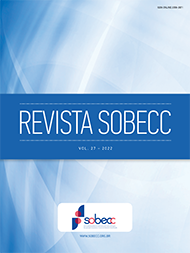Implementation of the PEWS and NEWS protocols in the post-anesthesia care unit
DOI:
https://doi.org/10.5327/Z1414-4425202227789Keywords:
Clinical deterioration, Recovery room, Perioperative nursing, Protocols, AutomationAbstract
Objective: To describe the development and implementation of the PEWS and NEWS protocols in post-anesthesia recovery using robotic automation. Method: Experience report on the development and implementation of clinical deterioration protocols in post-anesthesia recovery in a large philanthropic hospital located in the city of São Paulo, Brazil. The work involved the determination of protocols, construction of operational rules for the system, development of the electronic system and implementation with training of the assistance team. Results: Prediction of clinical deterioration was implemented with the PEWS and NEWS protocols in an automated way, and activation was signaled through an iconogram in the panel of the post-anesthesia care unit. Conclusion: The implementation of the protocols was successfully completed; the use of robotic automation can simplify workflows and reduce the time to collect vital signs to provide a score. Clinical deterioration protocols help nurses’ decision-making in anesthesia recovery, as long as they are applied in conjunction with clinical judgment.
References
Jardim DP, Machado LVL, Viegas K. Perfil e tempo de permanência de pacientes intensivos assistidos na recuperação pós-anestésica. REV SOBECC.2020;25(4):241-6. https://doi.org/10.5327/Z1414-4425202000040008
Sessler DI, Khanna AK. Perioperative myocardial injury and the contribution of hypotension. Intensive Care Med 2018; 44:811–822. https://doi.org/ 10.1007/s00134-018-5224-7.
Philips. The impact of Early Warning Scoring systems: Better health outcomes, lower cost of care, and improved staff, patient and family experience [Internet]. 2020. [acesso em 22 fevereiro de 2022]. Disponível em https://www.philips.com/c-dam/b2bhc/master/Specialties/general-care/respiratory-rate-measurement/impact-of-early-warning-scoring-systems-white-paper.pdf
Morgan RJM, Lloyd-Williams F, Wright MM. An early warning scoring system for detecting developing critical illness. An Early Warning Scoring System for detecting developing critical illness. Clin Intensive Care [Internet]. 1997 [acesso em 22 fevereiro 2022];8(2):100. Disponível em: https://www.tandfonline.com/doi/abs/10.3109/tcic.8.2.93.110
Institute for Healthcare Improvement (IHI). Early warning systems: scorecards that save live.[Internet]. 2019. [acesso em 22 fevereiro 2022]. Disponível em: http://www.ihi.org/resources/Pages/ImprovementStories/EarlyWarningSystemsScorecardsThatSaveLives.aspx
Grooth H, Girbes AR, Loer AS. Early warning scores in the perioperative period: applications and clinical operating characteristics. Curr Opin Anestesiol.2018;31:732-8. https://doi.org/10.1097/ACO.0000000000000657
Royal College of Physicians (UK). National Early Warning Score (NEWS): Standardizing the assessment of acute-illness severity in the NHS. [Internet]. 2012 [acesso em 22 fevereiro 2022]. Disponível em: https://www.rcplondon.ac.uk/projects/outputs/national-early-warning-score-news-2
Fox A, Elliott N. Early warning scores: a sign of deterioration in patients and systems. Nurs Manag (Harrow). 2015;22(1):26-31. https://doi.org/10.7748/nm.22.1.26.e1337
Oliveira AAA, Urbanetto JS, Caregnato RCA. National early warning score 2: adaptação transcultural para o português do Brasil. Rev Gaucha Enferm.2020;41:e20190424. https://doi.org/10.1590/1983-1447.2020.20190424
Miranda JOF, Camargo CL, Nascimento Sobrinho CL, Protela DS, Monaghan A, Freitas KS, et al. Tradução e adaptação de um escore pediátrico de alerta precoce.REBEN.2016;69(5):888-96. http://doi.org/10.1590/0034-7167-2015-0096
Credland N, Dyson J, Johnson MJ. Do early warning track and trigger tools improve patient outcomes? A systematic synthesis without meta-analysis. J Adv Nurs. 2021;77(2):622-34. htpp://doi.org/10.1111/jan.14619.
Kovacs C, Jarvis SW, Prytherch DR, Meredith P, Schimidt PE, Briggs JS, et al. Comparison of the National Early Warning Score in nonelective medical and surgical patients. Br J Surg 2016;103:1385 -93. htpp://doi.org/10.1002/bjs.10267
Bartkowiak B,Snyder AM,Benjamin A, Schneider A, Twu NW, Churpek MW., et al.Validating the Electronic Cardiac Arrest Risk Triage (eCART) Score for Risk Stratification of Surgical Inpatients in the Postoperative Setting: retrospective cohort study. Ann Surg 2019;269(6):1059-63. htpp://doi.org/10;1097/SLA.0000000000002665
Smith GB, Prytherch DR, Meredith P, Schmidt PE, Featherstone PI. The ability of the National Early Warning Score (NEWS) to discriminate patients at risk of early cardiac arrest, unanticipated intensive care unit admission, and death. Resuscitation 2013; 84(4):465-70. htpp://doi.org/ 10.1016/j.resuscitation.2012.12.016.
Boston L, Chadwell LA, Copeland K, Menser C, Shultz B. Pediatric early warning score (PEWS) implementation in the PACU. J Perianesth Nurs.2019;34(4):e56. https://doi.org/10.1016/j.jopan.2019.05.131
Jensen CS, Nielsen PB, Olesen HV, Kirkegaard H, Aagaard H. Pediatric early warning score systems, nurses perspective – a focus group study. J Pediatr Nurs.2018;41:e16-e22.htpp://doi.org/10.1016/j.pedn.2018.02.004
Downloads
Published
How to Cite
Issue
Section
License
Copyright (c) 2022 Cristina Silva Sousa, Andrea Alfaya Acuna

This work is licensed under a Creative Commons Attribution 4.0 International License.
By publishing in Revista SOBECC, authors retain the copyright of their article and agree to license their work using a Creative Commons Attribution (CC BY 4.0) International Public License, thus accepting the terms of this license. The CC BY 4.0 license allows others to distribute, remix, adapt, and create from the published article, even for commercial purposes, provided they give due credit to the creators of the work (authors of the article).
The authors grant to Revista SOBECC the right of first publication, to identify itself as the original publisher, and grant to the journal a non-exclusive license to use the work in the following ways: (1) to sell and/or distribute the article in hard copies and/or in electronic format; (2) to distribute parts and/or the entire article in order to promote the journal through the internet and other digital and printed media; (3) to record and reproduce the article in any format, including digital media.
With this license, authors can enter into separate contracts for non-exclusive distribution of the article (e.g., publishing in an institutional repository or as a book chapter), with acknowledgement of authorship and initial publication in Revista SOBECC. Authors are encouraged to publish and distribute their work online after publication in the Revista SOBECC, as this can increase the article's visibility and impact.
In line with the journal's policies, each published article will be assigned a CC BY 4.0 license, which will be visible on the abstract page and in the PDF of each article with the respective link to the license terms.











